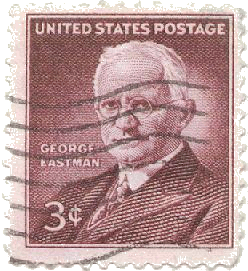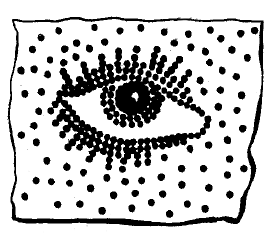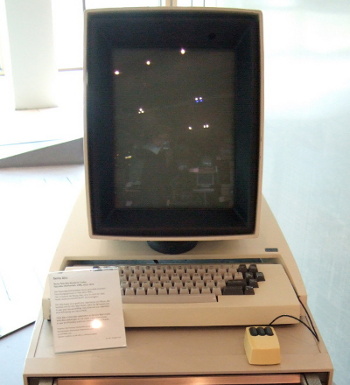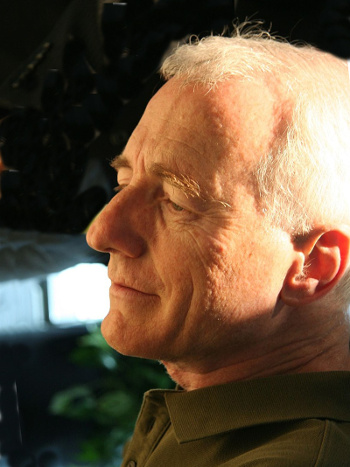Larry Tesler (1945-2020)
March 30, 2020
Large
corporations are run by
managers who often need to make important decisions about new
products and services. This can be a problem for
technology companies run by non-technologists. These managers are good at making business decisions, but are often lost when a decision involves an
emerging technology. When all you have is an
MBA,
everything looks like a business problem.
CEOs might consult with
middle managers who have an adequate technical background; but, even then, they often ignore threats to their company's
industrial dominance by those pesky
disruptive technologies. One illustrative example is
Kodak, of which I wrote about in an
earlier article (George Eastman and Kodak, February 21, 2012). Another is
General Electric.

Canceled in more ways than one.
The master of photography, George Eastman, rendered in an etching on a 1954 United States postage stamp.
Eastman named his company, Kodak, since he liked the sound of the letter "k." At its peak, in 1976, Kodak had 90% of film sales and 85% of camera sales in the United States.
Kodak was founded in 1888, so it's survived for more than 130 years. Its downfall was the emergence of digital photography. Since Kodak was a chemical company, it could not easily pivot into this electronics market.
(Via Wikimedia Commons.)
For one reason or another, some companies do the right thing. That's how a
Texas leather goods company,
Tandy Corporation, became involved with
personal computers with its
acquisition of
RadioShack in 1963. RadioShack introduced the
TRS-80 computer in 1977, the first in a
line of popular computers. The
BASIC interpreter for the TRS-80 was developed by
Microsoft, and apparently
coded by
Bill Gates, himself. RadioShack became such an important part of Tandy Corporation that it changed its name to RadioShack Corporation in 2000.
I remember an interesting
anecdote about TRS-80 BASIC. In a demonstration of the
language to the Tandy CEO, Gates had written a simple program to estimate how
expensive a
house could be
mortgaged based on your
annual income. When the CEO tried the program using his
salary, the BASIC interpreter couldn't handle such a large
number, and the program
crashed.
In the
history of computing, there's one corporation that stands near the top of the list for lost opportunities that are mixed among many accomplishments; namely,
Xerox. The Xerox
Palo Alto Research Center (PARC) was founded in 1970 in the heart of
Silicon Valley to
research new technologies to supplement its highly successful
photocopier business. I wrote about PARC on its 40th
anniversary in 2010 in an
earlier article (PARC Turns Forty, September 28, 2010). In 2002, PARC became a
wholly-owned subsidiary, which allows it to accept work from other companies. Xerox is a true technology company, and it owes its fortunes to the
Xerography invention of American
physicist,
Chester Carlson.
Carlson obtained his
physics degree at the start of the
Great Depression, he couldn't find a job in physics, so he took an
engineering position with
Bell Telephone Laboratories when it was still in
New York City. He eventually transferred to its
patent department as an assistant to a
patent attorney, eventually becoming the head of the patent department at
P. R. Mallory and Company. Carlson received an
LL.B. degree in 1939 by attending
law school at night.
Carlson conducted
experiments at
home on copy techniques different from the chemical
photographic techniques of the time. He eventually discovered that an
electrostatically-charged sulfur-coated
zinc plate could form an image, and he was able to transfer an image to
paper on October 22, 1938. Carlson's patent experience paid off with issuance of US Patent No. 2,297,691, "electrophotography," on October 6, 1942.[1]

Fig. 10 from Chester Carlson's Xerography patent.
Carlson's Xerography patent has 27 claims, the first of which reads as follows.
"The method of making a photographic reproduction which comprises applying a uniform layer of photoconductive insulating material to a plane conductive backing, developing a strong electrostatic charge on the surface of said layer by rubbing said surface, exposing the layer to a light image whereby to render the illuminated areas thereof sufficiently conductive to drain off a substantial proportion of said charge to said conductive backing, then bringing a fine dust into contact with the surface whereby to form an electro-static dust deposit on the areas of said surface remaining charged after the exposure, then blowing off excess dust not electrostatically held on said surface, whereby a dust image will be produced in which the dark areas of the original image will be reproduced as dust deposit areas."
(Via Google Patents.[1])
PARC invented
laser printing in 1971, and the
ethernet in 1975. Its lost opportunity centers around its 1973 creation of the
Alto computer. This computer was the first with a
graphical user interface, a
What-You-See-Is-What-You-Get text editor,
icons,
windows and
pop-up menus. In the midst of all this PARC activity was
Larry Tesler, who was
born on April 24, 1945, in the
Bronx, and
died on February 16, 2020, at age 74.[2] The Alto was famously
Steve Jobs' inspiration for
Apple's Lisa and
Macintosh computers. It was Tesler who demonstrated the Xerox Alto to Steve Jobs in 1979.[3]
Douglas Fairbairn, a
colleague of Tesler at PARC, is quoted by the
IEEE Spectrum as saying,
"Larry generated a lot of the basic ideas for the work we were doing... But he doesn’t have a big ego, so his name didn’t get attached to things. He wasn't the one guy who did one big thing you’ll remember him for; he was a collaborator on many things."[3]
As for most
successful people, Tesler's
career interest started in
childhood, when he was very interested in
mathematics. Since he had a
friendly personality, a
school guidance counselor suggested that he might enjoy a career as a
Certified Public Accountant.[3] That same guidance counselor would likewise have said that my
problem-solving skill and interest in
electronics would have made me an excellent
television repairman. Tesler attended the
Bronx High School of Science, noted for many
famous alumni, where a
teacher remarked that a
method the young Tesler had devised to generate
prime numbers could be done by a computer, and another student told him that
Columbia University had a program in which high school students could access a computer.
Tesler went on to earn his
B.S. degree in mathematics at
Stanford University (Stanford, CA) in 1965, and he tried his hand at computer
consulting, eventually returning to Stanford to work in its
Artificial Intelligence Laboratory.[3] While the AI work was interesting, Tesler realized that it would take
decades for it to become practical, and he moved to an
Oregon commune with his 5-year old
daughter.[3] There were no
employment opportunities in Oregon, so Tesler moved back to the
San Francisco Bay Area, where he would eventually join Xerox PARC. Another Stanford AI Lab
alumnus,
Alan Kay, had joined PARC, and he held Tesler in high regard.[3]
His first offer from Xerox was in its On-Line Office System Group, but Tesler was interested in personal computers, so he declined. In 1973, however, PARC was developing the Alto, so Tesler became part of Alan Kay's Learning Research Group.[3] Inspired by a
salesman who who told him that "It’s really hard to sell this stuff, the
software is just so unfriendly," Tesler starting thinking about
user-friendly interfaces.[3] He realized that most users didn't want to spend time learning all the commands that were needed to do the simplest things on a computer, such as
editing a
document.[3] In the design of a user-friendly interface, Tesler enlisted the aid of a newly hired
secretary, Sylvia Adams, to explain how she created documents on a
typewriter.[3]

A Xerox Alto terminal.
While this would be the standard footprint for one of today's desktop computers, these are just the user's input-output devices.
Since computing was still primitive at that time, all the computing power resided in a much larger piece of hardware connected to thekeyboard, mouse, and monitor.
(Cropped Wikimedia Commons image.)
Tesler's document creation and editing program,
Gypsy, incorporated the now familiar functions of
copy-and-paste,
search, selection of text using a mouse,
file click-to-open, and
what-you-see-is-what-you-get (WYSIWYG) printing.[3] Tesler coined the WYSIWYG phrase.[3] Although used internally by Xerox at its
Ginn and Company book publishing subsidiary, Gypsy was never
commercialized, so it was another lost opportunity for Xerox.[3] Tesler and some other PARC employees eventually joined Apple Computer after Steve Jobs' visit. Tesler, as quoted by the IEEE Spectrum, said,
"The questions the Apple people were asking totally blew me away... They were the kind of questions Xerox executives should have been asking but didn't. They asked: 'Why don't the windows refresh automatically? Why did you do the menus this way? You guys are sitting on a gold mine here. Why aren't you making this a product?'"[3]
Tesler remained at PARC until after his scheduled talk at the 1980
Association for Computing Machinery (ACM) SIGGRAPH conference.[3] The reason for this is that the talk would remove
trade secret status from some
word-processing work at PARC, so he could work on similar technology at Apple without any
legal problems.[3] Tesler was key to the Lisa development;[3] but, one failing, in my estimation, was his arguing for a
one-button mouse. I always hated using my
mother's Macintosh because of the one-button mouse. Lisa, however, was an
expensive system, and only 30,000 were sold in its two year production run.[3] I actually saw a newly purchased Lisa early in my
corporate research career, not in our laboratory building, but at the
executive suite.

Larry Tesler in 2007.
Most news articles about Tesler's death highlight the copy-and-paste commands that he pioneered.[2] Most people access copy and paste through a menu obtained by right-clicking their mouse.
Most of the time, I use the keyboard shortcuts of Control-C (ctrl-C) for copy, and Control-V (ctrl-V) for paste. Using ctrl-C for copy makes sense (although it's the terminate command in a terminal session), but why ctrl-V and not Control-P (ctrl-P) for paste?
Ctrl-P is often used as the print command; and, in a true Wikipedia citation needed explanation, ctrl-V was used instead since V is near C on a QWERTY keyboard.
(Modified Wikimedia Commons image from the Yahoo! Blog. Click for larger image.)
Tesler became
vice president of the
Apple Advanced Technology Group in 1986, a group that employed about 200 people, that assisted in development of the
Macintosh II.[3] In 1990, in what Tesler called the worst decision of his career, he decided against a
handheld Mac and in favor of the
Newton, a handheld computer that was not Mac-
compatible.[3] His first order of business was to reduce the sale price of the Newton from $7000 to $1000, and he found a way to do this by using a
reduced instruction set (RISC) computing chip. To that end, Apple
invested in newly created
Advanced RISC Machines Ltd.[3]
Among Newton's problems was its flawed
handwriting recognition, which is something that my
Palm Zire 31 with its
Graffiti 2 character recognition did very well a few years later. The Newton handheld computer was a
market failure, and Tesler remain at Apple for four additional years as
chief scientist.[3] He left Apple in 1997 after disbanding his Advanced Technology Group, later working at
Amazon and
Yahoo!.[3]
References:
- Chester F. Carlson, "electrophotography," US Patent No. 2,297,691 (October, 1942).
- Scott Simon, "Remembering The Pioneer Behind Your Computer's Cut, Copy And Paste Functions, NPR Weekend Edition Saturday, February 22, 2020.
- Tekla S. Perry, "Of Modes and Men - Cut-and-paste, the one-button mouse, WYSIWIG desktop publishing - these are just a few of the user interface innovations pioneered by Larry Tesler," IEEE Spectrum, August 1, 2005.
Linked Keywords: Corporation; management; manager; goods and services; products and services; technology; company; emerging technology; Master of Business Administration; MBA; law of the instrument; everything looks like a business problem; chief executive officer; CEO; middle management; middle manager; industry; industrial; disruptive innovation; disruptive technology; Eastman Kodak; General Electric; photography; George Eastman; etching; United States; postage stamp; he liked the sound of the letter "k"; photographic film; camera; digital photography; chemistry; chemical; pivot; electronics market; Wikimedia Commons; Texas; leather goods; Tandy Corporation; personal computer; mergers and acquisitions; acquisition; RadioShack; TRS-80 computer; Tandy-branded computers; BASIC; interpreter (computing); Microsoft; source code; coded; Bill Gates; anecdote; programming language; cost; expense; expensive; house; mortgage loan; annual; income; salary; number; crash (computing); history of computing; Xerox; PARC; Palo Alto Research Center; Silicon Valley; research; photocopier; anniversary; >wholly-owned subsidiary; Xerography; physicist; Chester Carlson; physic; Bachelor of Science; degree; Great Depression; engineer; engineering; Bell Labs; Bell Telephone Laboratories; New York City; patent; patent attorney; P. R. Mallory and Company; Bachelor of Laws; LL.B. degree; law school; experiment; photographic; electric charge; electrostatically-charged; sulfur; zinc; paper; claim (patent); Google Patents; laser printer; laser printing; ethernet; Xerox Alto; desktop computer; graphical user interface; WYSIWYG; What-You-See-Is-What-You-Get; text editor; icon (computing); window (computing); context menu; pop-up menu; Larry Tesler; birth; born; The Bronx; death; died; Steve Jobs; inspiration; Apple Inc.; Apple Lisa; Macintosh; colleague; IEEE Spectrum; idea; ego; collaboration; collaborator; success (concept); successful; career; childhood; mathematics; agreeableness; friendly personality; high school; guidance counselor; Certified Public Accountant; problem-solving; skill; electronics; television; repairman; Bronx High School of Science; Bronx High School of Science alumni; teacher; algorithm; method; prime number; Columbia University; Bachelor of Science; B.S. degree; Stanford University (Stanford, CA); consultant; consulting; Stanford Artificial Intelligence Laboratory; decade; Oregon; commune; daughter; employment; San Francisco Bay Area; alumnus; Alan Kay; sales; salesman; software; usability; user-friendly; user interface; editing; document; secretary; typewriter; computer terminal; footprint; desktop computer; input-output; computing; computer hardware; computer keyboard; computer mouse; computer monitor; cut, copy, and paste; copy-and-paste; search algorithm; computer file; point and click; click-to-open; what-you-see-is-what-you-get (WYSIWYG); printing; Ginn and Company; book; publishing; subsidiary; commercialization; commercialize; Association for Computing Machinery (ACM); SIGGRAPH conference; trade secret; word processor (electronic device); word-processing; law; legal; Apple one-button mouse; mother; Research and development; corporate research; executive suite; menu (computing); context menu; right-clicking; keyboard shortcut; Control-C (ctrl-C); Control-V (ctrl-V); Control-P (ctrl-P); Wikipedia citation needed; QWERTY keyboard; Yahoo! Blog; vice president; Apple Advanced Technology Group; Macintosh II; handheld PC; Apple Newton; computer compatibility; compatible; reduced instruction set (RISC); microprocessor; computing chip; investment; invested; Arm Holdings; Advanced RISC Machines Ltd; handwriting recognition; Palm Zire 31; Graffiti 2; market (economics); chief scientific officer; chief scientist; Amazon.com; Yahoo!; Chester F. Carlson, "electrophotography," US Patent No. 2,297,691 (October, 1942).